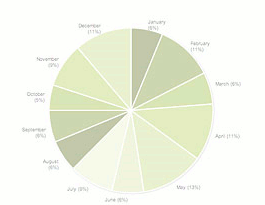


Stereotype Threat Raises Its Ugly Head Again
Dear friends of women in science,
Recently Sonia Pressman Fuentes alerted me that a new book has come out, and womensenews.org covered it with an item featuring our old enemy, stereotype threat. Boston University professor Caryl Rivers, along with co-author Rosalind C. Barnett, senior scientist at the Brandeis Women's Studies Research Center, have just released their book, The Truth About Girls and Boys: Challenging Toxic Stereotypes About our Children (Columbia University Press). The two wrote the item for womensenews.org on Friday, May 25, entitled "Female 'Stereotype Threat' Brain Drains U.S. STEM."
The authors point out that old ideas about women's inability to do the math and science are "falling like dominos," but ask if women themselves believe they can do it and do it well. They cite a study of Pascal Huguet on French middle school girls who, in the classical stereotype threat paradigm, do less well on math tests if told that boys generally do better in math than girls.
The Girl Scouts Foundation reported, they say, that "74 percent of teen girls are interested in STEM and 82 percent see themselves as smart enough to have a career in STEM." But this optimistic view does not seem to hold up for women a bit older. Women don't earn half the college degrees in physical sciences and engineering, and even those women who do complete the majors tend to go into education and health care positions, not strictly physical science or engineering jobs. That's true even though women who do persist in STEM are paid better than those in most other fields, albeit not quite as well as the men in their fields.
The real concern they raise is about competitiveness and how a low level of women's interest in STEM careers might impact that. They note that "Rebecca Blank, acting deputy secretary of the Commerce Department, warns that the lack of women in STEM is harming U.S. ability to compete in the global innovation marketplace."
The authors suggest that telling girls about how STEM careers can help people solve important problems in their everyday lives, a message that is often hidden until much later, would be motivating for girls to stay around. They point out that "scientific teams drastically reduced childhood leukemia, are saving the everglades, preserving sea turtles in the Caribbean, reducing AIDS in Africa, learning how to save lives by predicting volcanic eruptions and solving crimes through forensic science. This is too often not what girls think when they hear the words 'math and science.'"
So, although they note that girls sometimes still think they aren't supposed to be good at math, there are some hopeful signs as well as rewards for those who stay in the field. We just need to get the message out to them.
cheers,
Laura

Hi Laura,
I'm addressing your answer to Phoebe's comment:)
I'm not aware of studies, but I can speak from personal experience that I've been on committees with all men and the climate is very different compared to an all female science committee.
Being in the majority shifts your perspective and confidence profoundly even when you don't know the people involved. In fact attending a conference that was 95% women made a huge difference in how I viewed the male/female science dynamic.
It was a turning point for me to leave academic science as I finally realized how it would always be different for me going to conferences/grant reviews/etc. compared to my male colleagues solely based on my gender. And how much I was missing out on!
That was not the endpoint that the NSF ADVANCE grant holders had in mind when they put it on, I'm sure! But after that conference, going to predominantly male ones made it even harder because of the contrast.
Hi Nancy,
You could be right, but I'm wondering what sort of limited venue you have in mind. Is it just at early ages, do you think?
cheers,
Laura
Hi Phoebe,
I think it would be a possibility, at least, that in some settings adult women in science succumb to it too. I'm thinking about when they attend a scientific meeting with almost all men, for example a couple of recent ones on genomics, or when they're appointed to a committee to select award winners, and all the others are male Nobel laureates.
There would be an unwritten, unspoken implication there that women aren't so good at the subject or so likely to get this award, it seems to me, and the men aren't likely to address it verbally to defuse that message.
Does anyone know of data out there on that issue?
cheers,
Laura
Hi Helen,
I think there are, and I've seen evidence that building confidence in your ability, as Girl Scouts does, is part of the answer. Also, they need to have the threat explicitly disarmed. That may be what Phoebe is suggesting professors need to take the valuable few minutes to do. Just saying something like "evidence shows that anyone can do well on this type of examination" can do wonders.
cheers,
Laura
Hi Laura,
I agree that I would guess that the most impact is through the undergraduate level and prior. There are plenty of studies showing the first divergence at the middle school level for girls when gender roles become more enforced and stereotypes gain more power.
One thing to think about in the Girl Scout data is that they may be observing the effect of the program on girls' confidence and thus resistance to sterotype threat. We know that athletics for example strengthens resistance. Perhaps other confidence programs can do the same that are independent of science?
My point is that disabling the threat with studies that show it is not based in reality is one part. But there may already be effective tools for giving girls mental armor to protect them from it if we can just use them.
Cheers,
Helen
Dear Everyone,
I think stereotype threat is very important, especially in my work with undergraduates. It is so easy to do just a few simple things to mitigate against stereotype threat that I do not understand why all science professors do not take the 2-3 minutes to do so before an exam. As far as stereotype threat affecting faculty-level women scientists, I would love to participate in some kind of study to learn about this. On a related note, I have often wondered how stereotype threat might affect scientists who have our primary appointments at non-research I universities -- when we perform under "exam" conditions such as on a grant or in a meeting, are we affected by stereotype threat because of stereotypes that only mediocre (or worse) scientists would work at small undergraduate colleges? And is there a gender difference in the threat (if one exists)?
Dear Laura,
This situation is complex, and these authors are neither of them actually in science, but they do collect a lot of current thinking and some experimental evidence in one book. I suspect stereotype threat is important, but in a more limited way than they would suggest here.
NRH

















